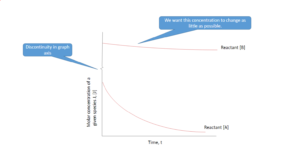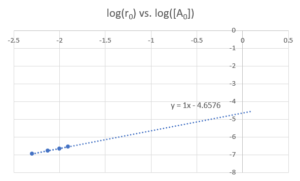13 Reaction Order
Learning Objectives
By the end of this section, you should be able to:
Define reaction order and overall order
Determine the reaction order and the rate constant from kinetic data
The dependence of the rate of reaction on the reactant concentrations can often be expressed as a direct proportionality, in which the concentrations may be raised to be the zeroth, first, or second power. The exponent is known as the order of the reaction with respect to that substance.
The overall order of a reaction is the sum of the orders with respect to the sum of the exponents
For example:
The reaction is:
- Third-order in A
- One-half order in B
- Three and a half order overall
In the more complicated example for the reaction previously given between hydrogen and bromine:
The reaction is:
- First order in
- Indeterminate order in
- Indeterminate order in
- Indeterminate order overall (as some orders are indeterminate)
Determining the Rate Law
Isolation Method for Determining the Rate Law
One of the simplest methods for determining the rate law is the isolation method.
Say we have a reaction with two reactants, A and B. We put a large amount of B in our reactor compared to A; so much that the concentration barely changes.
If the true rate law is:
What we would observe is

With B in great excess:
With A in great excess:
It is easier to analyse these individual effective rate laws than the more complex combined rate law when both concentrations change significantly.
Method of Initial Rates
The method of initial rates is commonly used in conjunction with the isolation methods to determine reaction order.
Exercise: Method of Initial Rates
Say we have a reaction with two species, A and B. We put in the same amount of B into the reactor each time. The following is our initial rates are observed with different concentrations of A. What is the reaction order in A?
| [A] (mol/L) | Initial rate(mol/L·s) |
| 1 | |
| 2 |
Solution
As the concentration of A doubles, the reaction rate quadruples
So the reaction is second order in A.
If we take the logarithm of the general equation for reaction rate, we can linearize the equation:
Plot
Exercise: Reaction Order and Rate Constant
Sulfuryl chloride (
Data for the reaction at 320°C are listed in the following table. Calculate the reaction order with regard to sulfuryl chloride and determine the rate constant for the reaction.
| Experiment | Initial rate(M/s) | |
| 1 | 0.0050 | |
| 2 | 0.0075 | |
| 3 | 0.0100 | |
| 4 | 0.0125 |
Solution
Step 1: determine the reaction order with respect to sulfuryl chloride
Comparing Experiments 1 and 3, for example, shows that doubling the concentration doubles the reaction rate
The reaction is first order with respect to
Step 2: calculate
We have
Method 2
The following graph is produced when plotting

From the line of best fit, we can see the slope is 1 (meaning a first order relationship) and
Therefore the reaction is first order in
References
[1] Chemistry LibreTexts. 2020. The Rate Law. [online] Available at: <https://chem.libretexts.org/Bookshelves/Physical_and_Theoretical_Chemistry_Textbook_Maps/Supplemental_Modules_(Physical_and_Theoretical_Chemistry)/Kinetics/Rate_Laws/The_Rate_Law> [Accessed 23 April 2020].
[2] Chemistry LibreTexts. 2020. 14.4: The Change Of Concentration With Time (Integrated Rate Laws). [online] Available at: <https://chem.libretexts.org/Bookshelves/General_Chemistry/Map%3A_Chemistry_-_The_Central_Science_(Brown_et_al.)/14%3A_Chemical_Kinetics/14.4%3A_The_Change_of_Concentration_with_Time_(Integrated_Rate_Laws)> [Accessed 23 April 2020].


Feedback/Errata